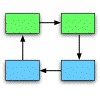 |
Problems for
Intermediate Methods in Theoretical Physics
Edward F. Redish |
The Dirac Delta
Function
In lecture, we introduced the Dirac delta function in order to be able to write
 .
.
We defined the delta function as
 .
.
(a) Use the definitions to argue the following properties of the delta function:
- The delta function is
a generalization of the Kroenecker delta, δij = 0 for i ≠ j; that is, δ(x-x') = 0 if x ≠ x'.
- The delta function is only a function of the difference between x and x'.
- In some (difficult to
determine) sense, δ(x-x') is infinite for x = x'.
(b) For some applications we will have to use the delta function of a function of x rather than just of x itself. (For example when we want to integrate over momentum states -- p -- but want to conserve energy -- E = p2/2m.) Show that:
 .
.
where the set of xi are the solutions (there may be more than one) of the equation
g(x) = 0.
RETURNS
| University of Maryland | Physics Department | Physics 374 Home |
 |
 |
 |
This page prepared by
Edward F. Redish
Department of Physics
University of Maryland
College Park, MD 20742
Phone: (301) 405-6120
Email: redish@umd.edu
Last revision 13. November, 2005.


 .
. .
.

